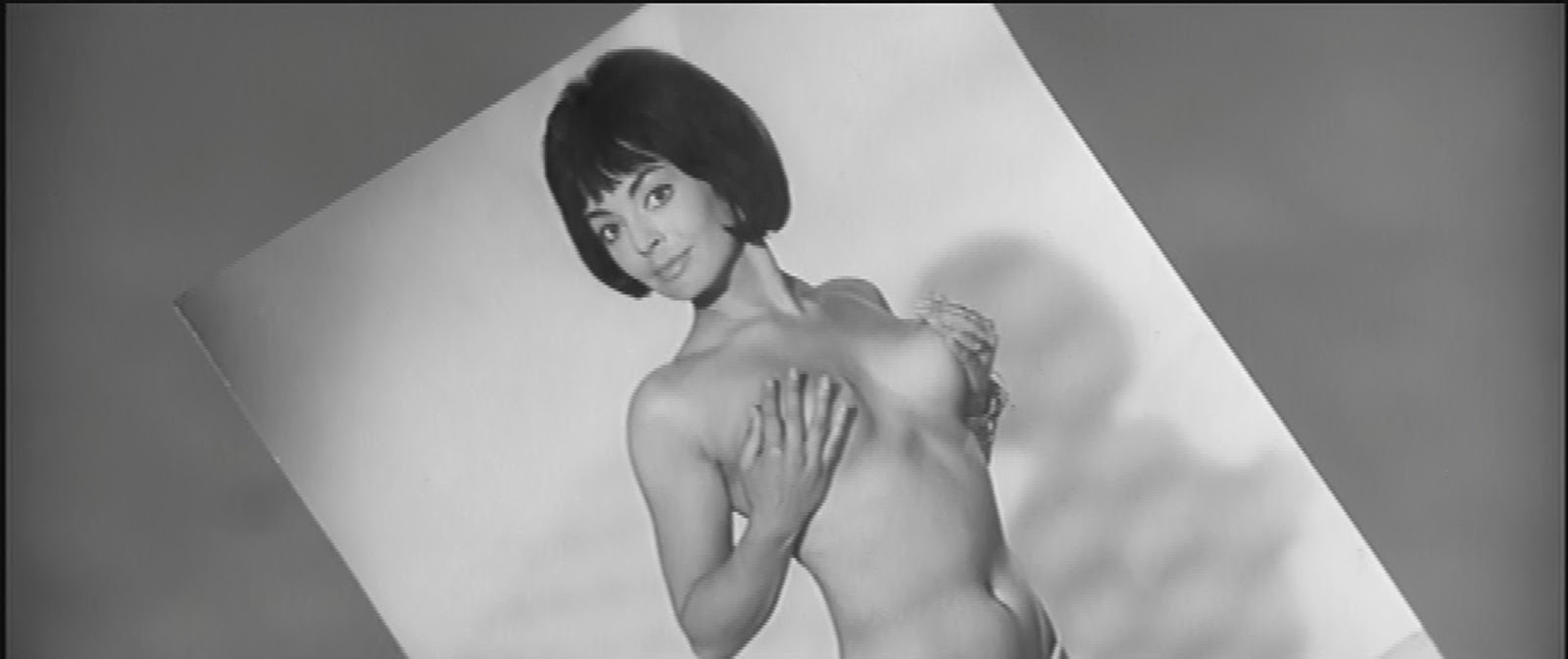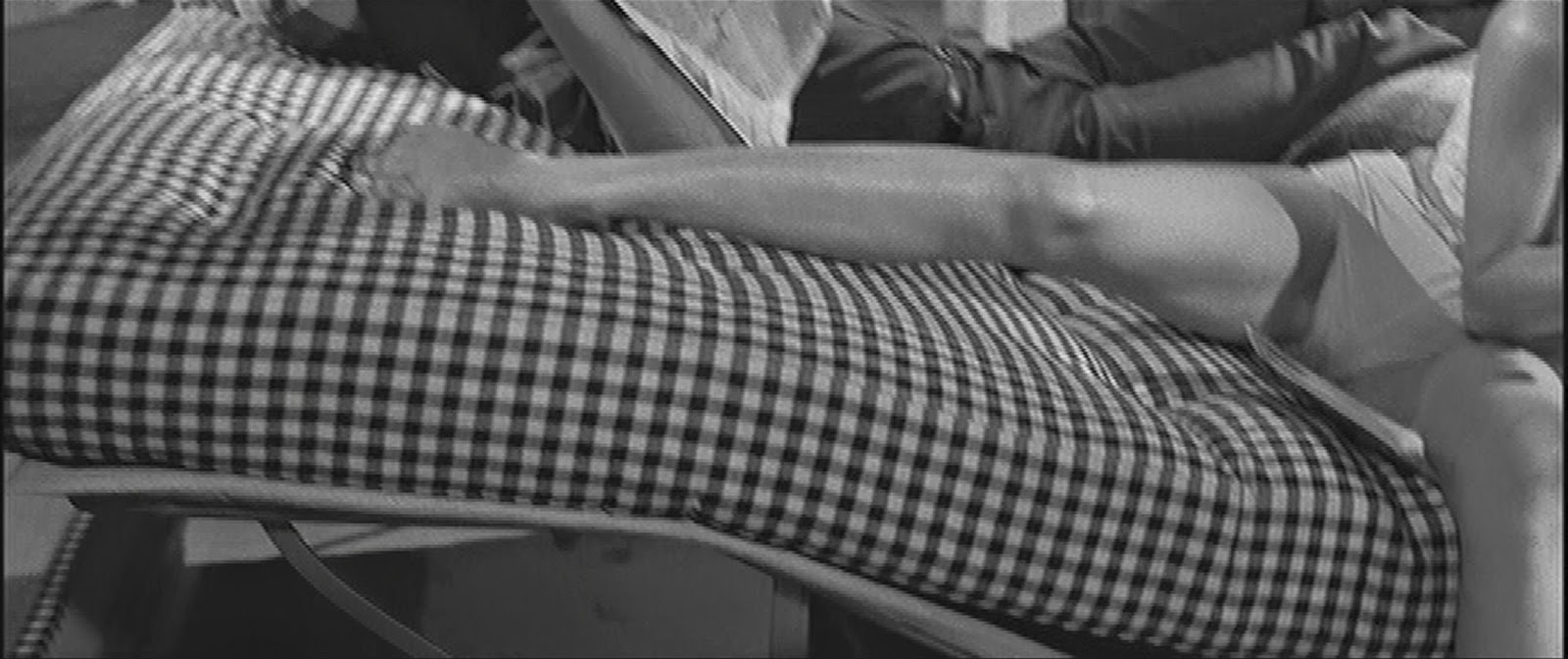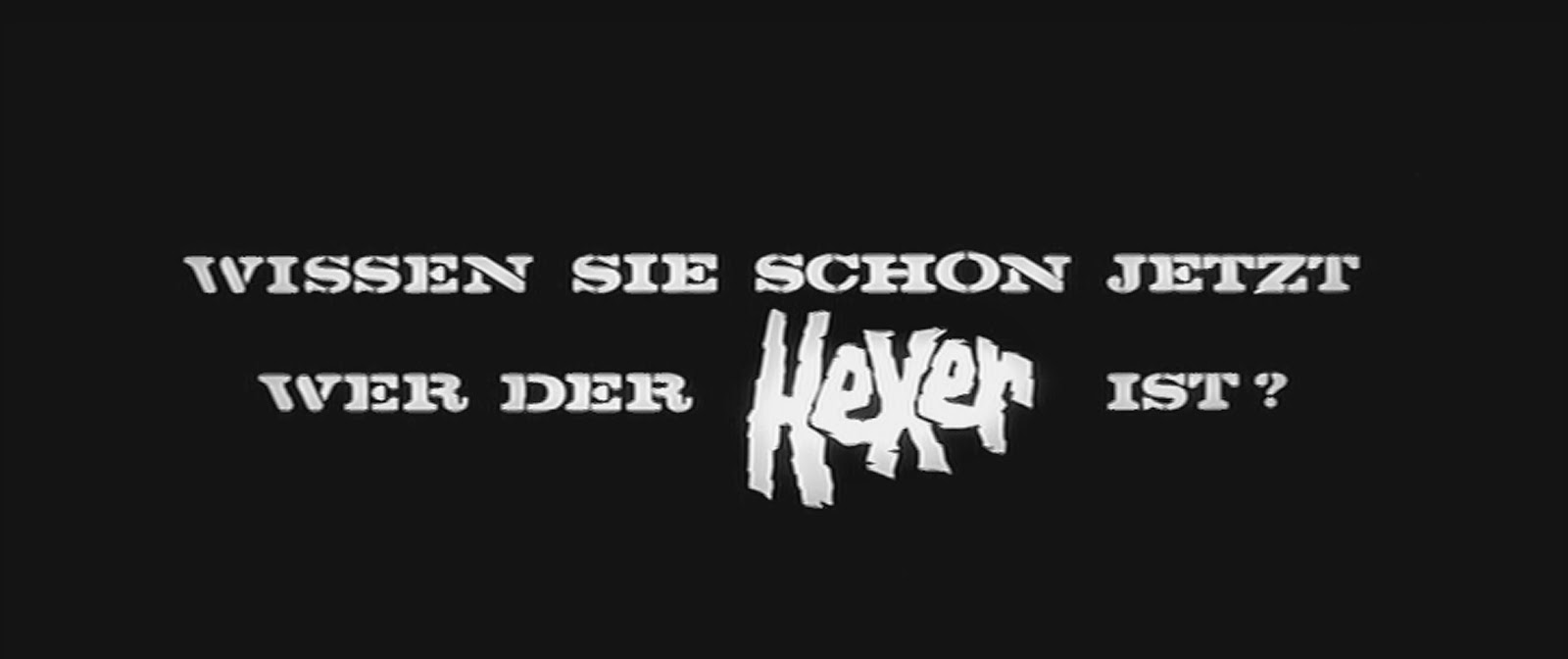[Note:
This is the sixth post in a continuing series discussing and analyzing
our favorite Krimis and Gialli (some of the reviews started as rough
drafts on my Letterboxd account). As with every post on this site, SPOILERS SHOULD BE EXPECTED. ALSO, SOME IMAGES IN THIS POST BORDER ON NSFW.]
My Krimi Rating: ★★★★★
Subcategory (if any):
i. Heist / Master Criminal Krimi
ii. Boarding School Krimi
iii. Arent-as-Human-Being Krimi
iv. Krisis-in-the-Krimiverse Krimi
Who Portrays the Detective (amateur or official):
Joachim Fuchsberger (official); Heinz Drache (official) Siegfried Lowitz (official)
Who's the Ingénue:
There isn't one
In My Krimi Top 20 (Y/N): Yes (Letterboxd link)
[1. THE FIRST MOST INTERESTING THING ABOUT THIS MOVIE]
This movie is kind of a Bizarro World Krimi—a collision of two, parallel fictional universes that exist side-by-side in the larger Krimi-verse. This is because we get both Joachim Fuchsberger and Heinz Drache in the same movie, on the same screen, shadowing each other through the story as dueling detectives after the same elusive phantom (Der Hexer, the Mysterious Magician, the master of disguise who has returned from a self-imposed exile in Australia to avenge his sister's death). The vast majority of the Krimis I've seen so far feature either Drache (in at least 9 films) or Fuchsberger (at least 18 films) as the film's lead investigator. Sometimes an official Scotland Yard inspector. Sometimes an American amateur sleuth-slash-rich playboy. Sometimes a world-weary cynic trying to find out what, in fact, was done to Solange.
This movie is kind of a Bizarro World Krimi—a collision of two, parallel fictional universes that exist side-by-side in the larger Krimi-verse. This is because we get both Joachim Fuchsberger and Heinz Drache in the same movie, on the same screen, shadowing each other through the story as dueling detectives after the same elusive phantom (Der Hexer, the Mysterious Magician, the master of disguise who has returned from a self-imposed exile in Australia to avenge his sister's death). The vast majority of the Krimis I've seen so far feature either Drache (in at least 9 films) or Fuchsberger (at least 18 films) as the film's lead investigator. Sometimes an official Scotland Yard inspector. Sometimes an American amateur sleuth-slash-rich playboy. Sometimes a world-weary cynic trying to find out what, in fact, was done to Solange.
 |
Matter, meet Anti-Matter (with a mirror
image in frame no less). I have to assume this is the only instance where the two detective leads shared the same film.
|
For my tastes, Drache has always been the poor man's
Fuchsberger, and perhaps it feels that way because F. originated the ubiquitous detective character in the first "official" Edgar Wallace Krimi, THE FACE OF THE FROG. Either way, I can't adequately express how much cinematic
pleasure I get out of seeing the two share the same classic Krimi stage. It makes for a slightly askew "crossover" atmosphere, a kind of CRISIS ON INFINITE EARTHS that allows the Golden Age version of a superhero to share the same space as the Silver Age version. Or matter and anti-matter, with the moment that Drache and Fuchsberger shake hands threatening to explode their colliding Krimi-verses. (Imagine if you were watching a television show where one character had been played, during the course of the series, by multiple actors. And seeing an episode where all of those actors existed simultaneously in the story, *as that character*. Or, maybe like that DR. WHO anniversary movie where multiple Doctors share the same storyline. Or an episode of BEWITCHED featuring both Dick York AND Dick Sargent [for all I know, there is an episode like this]. Or that episode of MST3K that has both Joel and Mike in it. Or ... you get the idea.)
And this slightly mind-bending, narratively impossible
“crossover” atmosphere is appropriate for the story, as the title
villain is a master of disguise, capable of taking over other people's identities as if by magic, someone who could potentially be, at one time or another, literally every single male character in the film. He's a shadowy, theatrical master criminal in a genre that's knee-deep in them; as the movie progresses he makes his case for being *the* iconic criminal of the entire series.
Combine this uber, shape-shifting mastermind with Drache and Fuchsberger smirking, chasing, undercutting (also: overlapping) each other's screen persona and it all adds up to something that feels very “meta,” very self-aware. And not in the usual way these films play self aware: as comic relief. E.g., the unfortunate tendency for characters in the movies (usually played by Eddi Arent) to break the fourth wall with some sort of "Ende" title card joke. Here the fourth-wall-warping feels genuinely trippy. Self-referential and slightly hard to wrap your fan's head around.
That is the first most memorable thing
about the movie.
 |
| Unmasking the Hexer, who has been wearing Inspector Warren's face maybe all along. Note the similar staging to the shot above. |
[2. THE SECOND MOST INTERESTING THING ABOUT THIS MOVIE]
The second most interesting thing about the movie is how far ahead (ahead of other entries up till then) it pushes overt elements of eroticism and sex. Other than some unique examples (again, FACE OF THE FROG comes to mind; seems like a theme developing), the sequences meant to titillate here push ahead not only in terms of their duration, how much screen time gets devoted to them, but also in terms of how much gets *shown*.
This in a series that feels, up until this entry, positively rooted in the past in terms of the sex/skin/sensuality that it allows itself to show (or for that matter, to even imply). This trend of course changes before the Krimis die out, with entries like the aforementioned WHAT HAVE YOU DONE TO SOLANGE? observing almost no self-censorship in terms of story or onscreen displays (illegal abortions, showering schoolgirls, those same schoolgirls being brutally murdered [often in the nude], teachers having illicit relationships with those schoolgirls, etc.). But it's a very different tone that's observed in the first phase of the genre ... except when we get to outliers like this.
(When I write up FACE OF THE FROG, I'll highlight the specific erotic sequences that seem to push confidently past their time [also past the Krimi's particular trajectory].)
So how does it show up here? We get our first glimpse when it's revealed that Fuchsberger's detective apparently uses his Scotland Yard equipment to take and develop semi-nude photos of his secretary:
This isn't so far
out of the bounds of what you might expect, other than it seems to
suggest that the usually stalwart, dedicated-to-his-duty Scotland
Yard detective is, here, as interested in taking nudie snaps in his
office as doing any real work. It plays as a contrast, esp. to the
way Fuchsberger has portrayed the detective character up until this
point. Though he routinely has a love interest—most often the
“ingenue in distress,” who he first saves from the villain and then marries—that
lovey-dovey, "happy ending" plot trajectory rarely contains anything approaching the
sexual, or erotic.
The second erotic sequence is actually two or three sustained scenes strung together, that feel pretty daring in what they're willing to show. They involve Fuchsberger and Sophie Hardy, the angry girlfriend from the opening office scene. Despite his philandering, she is dead-set on getting a marriage proposal out of him (something about her characterization—and the film's treatment—that works against how modern it feels otherwise). It's unclear whether they live together, or just spend an awful lot of time together in her apartment. He's free to visit her while in the shower though:
This leads, a few scenes later, to the two of them, post-shower, lounging on an electric daybed. Fuchsberger is on his back, reading the paper. He is at an impasse in the chase for the Hexer. Hardy, barely dressed (in a way that seems like it surely must've been right on the edge, censorship-wise), is reclining at the opposite end, trying to get F.'s attention:
 |
| Other than the nudity that shows up, in blips, in PHANTOM OF SOHO and MONSTER OF LONDON CITY (also both from 1964), I assume this is one of the first instances of this kind of skin in the genre. |
 |
Their embrace gets interrupted by a call from Sir John:
I don't include these shots to be crass or leery, but to demonstrate just how much gets shown in this several-minute's-long sequence. Everything she does is meant to arouse Fuchsberger's attention, to give him ample reason to ignore the phone and hide out in her apartment from the case, and Sir John. It really feels like the sort of thing you would see in a Giallo a decade later (though, most likely in the Giallo, it would be followed by gratuitous nudity and/or a simulated love scene).
The combination of these two elements
really amps up how fresh and contemporary it feels, shaking off any dated associations (with a genre that is often accused of feeling dated) and marks this movie as one of the “key texts,” one of the cornerstone examples of just how daring, forward-looking, experimental, and (yes) erotic these movies can be. Sans the often grating, goofy tone.
[3.MISCELLANEOUS WHAT'S LEFT]
What else makes an impression?
Firmly in my top 4 Krimis, and makes me anxious to watch the sequel.
[3.MISCELLANEOUS WHAT'S LEFT]
What else makes an impression?
- The prologue murder. This is something of a staple for Krimis. This one stands out because 1) the murder victim is Cora Ann Milton, the Hexer's sister; without her murder, the rest of the movie wouldn't take place, and the Hexer would've never been forced to try to sneak his way back to London for revenge. And 2) the masterful transitions used to develop the scene:
- The music. Somehow I've so far neglected to really discuss the top-notch, weirdo soundtracks that help define these movies. Musical landscapes that are, in their own way, as distinctive as anything you've come to recognize from, say, Goblin. Some mix electronic noise and rock experimentation. Some are toe-tapping yet atonal and anarchic. Big bands are crossed with schmaltzy pop. There are avant-electronic scores provided by the composer who did Hitchcock's THE BIRDS. Etc.
The title track here includes female voices squealing (also, oohing, aahing, and playfully shrieking); male and female voices keeping the beat with a dah-dah-dah-dah, dah-dah-dah-dah chorus; manic laugh tracks; and, above all, an infectious, off-kilter energy. There are probably more examples of iconic pieces of music to be found in the Giallo genre, but maybe only because there are so many more Gialli in the world. When Krimi soundtracks make good, they make great. And are as integrally important to the success or failure of the film as any subsequent Italian genre. Martin Bottcher and Peter Thomas are two of the ones whose work I've come to recognize the most.
- More doubling, more symmetry, more enstranging style:
 |
The note leads Drache to an abandoned
estate, number double eight (infinity symbols standing side-by-side,
mirror images for mirrored characters/mirrored spaces).
|
 | |
 |
| So much for symmetry. Two villains dynamite the abandoned building in an attempt to murder Drache. |
 |
| Shades of VERTIGO. |
 |
Fuchsberger peeping a woman dressed
like an extra from LOGAN'S RUN.
|
Firmly in my top 4 Krimis, and makes me anxious to watch the sequel.
Leonard Jacobs
September, 2014
[SHOW NOTES]










































No comments:
Post a Comment